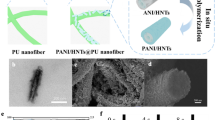Abstract
Polyvinylchloride (PVC) powders containing (or not) calcium carbonate were mechanochemically modified using a ball mill. Membranes prepared by phase inversion of the modified PVC were tested by scanning electron microscopy, infrared spectroscopy, thermogravimetry, and differential scanning calorimetry to compare the structure and properties before and after mechanochemical modification. The results showed that after mechanochemical modification, pure water flux of the phase inversion PVC membrane reached up to 378.6 L/(m2 h), significantly higher than that before modification [123.3 L/(m2 h)]; calcium carbonate enhanced the dechlorination effect of mechanochemical modification and further increased pure water flux of the membrane to 454.2 L/(m2 h). Mechanochemical modification increased the tensile strength of the PVC membrane by 4.1 % and decreased crystallinity of the PVC powder by about 34 %.












Similar content being viewed by others
References
Zhang X, Chen Y, Konsowa AH, Zhu X, Crittenden JC (2009) Evaluation of an innovative polyvinyl chloride (PVC) ultrafiltration membrane for wastewater treatment. Sep Purif Technol 70:71–78
Hu XY, Chen YB, Liang HX, Xiao CF (2011) Preparation of polyurethane/poly(vinylidene fluoride) blend hollow fiber membrane using melt spinning and stretching. Mater Sci Technol 27:661–665
Yeow ML, Liu YT, Li K (2005) Preparation of porous PVDF hollow fibre membrane via a phase inversion method using lithium perchlorate (LiClO4) as an additive. J Membr Sci 258:16–22
Itta AK, Tseng HH, Wey MY (2010) Effect of dry/wet-phase inversion method on fabricating polyetherimide-derived CMS membrane for H2/N2 separation. Int J Hydrog Energy 35:1650–1658
Riyasudheen N, Sujith A (2012) Formation behavior and performance studies of poly(ethylene-co-vinyl alcohol)/poly(vinyl pyrrolidone) blend membranes prepared by non-solvent induced phase inversion method. Desalination 294:17–24
Mei S, Xiao CF (2011) Hydrolysis modification of PVC/PAN/SiO2 composite hollow fiber membrane. Desalination 280:378–383
Alsalhy QF (2012) Hollow fiber ultrafiltration membranes prepared from blends of poly(vinyl chloride) and polystyrene. Desalination 294:44–52
Bodzek M, Konieczny K (1993) Ultrafiltration membranes made of vinyl chloride-vinyl acetate copolymer. J Membr Sci 76:269–279
Hosseini SM, Madaeni SS, Khodabakhshi AR, Zendehnam A (2010) Preparation and surface modification of PVC/SBR heterogeneous cation exchange membrane with silver nanoparticles by plasma treatment. J Membr Sci 365:438–446
Sacristán J, Reinecke H, Mijangos C (2000) Surface modification of PVC films in solvent-non-solvent mixtures. Polymer 41:5577–5582
Kim DS, Kang JS, Kim KY, Lee YM (2002) Surface modification of a poly(vinyl chloride) membrane by UV irradiation for reduction in sludge adsorption. Desalination 146:301–305
Nomura Y, Fujiwara K, Terada A, Nakai S, Hosomi M (2012) Mechanochemical degradation of γ-hexachlorocyclohexane by a planetary ball mill in the presence of CaO. Chemosphere 86:228–234
Kano J, Zhang Q, Saito F, Baron M, Nzihou A (2006) Synthesis of hydroxyapatite with the mechanochemical treatment products of PVC and CaO. Process Saf Environ Prot 84:309–312
Tongamp W, Zhang QW, Saito F (2006) Mechanochemical decomposition of PVC by using La2O3 as additive. J Hazard Mater 137:1226–1230
Pi H, Guo SY, Ning Y (2003) Mechanochemical improvement of the flame-retardant and mechanical properties of zinc borate and zinc borate-aluminum trihydrate-filled poly(vinyl chloride). J Appl Polym Sci 89:753–762
Madaeni SS, Bakhtiari L (2012) Thermodynamic-based predictions of membrane morphology in water/dimethyl sulfoxide/polyethersulfone systems. Polymer 53:4481–4488
Xu J, Xu ZL (2002) Poly(vinyl chloride) (PVC) hollow fiber ultrafiltration membranes prepared from PVC/additives/solvent. J Membr Sci 208:203–212
Mei S, Xiao CF, Hu XY (2009) Structure and property of poly(Vinyl Chloride)/inorganic particle composite membrane. Polym Mater Sci Eng 25:60–63
Lin YZ, Li YG, Chen CX, Li JD (2006) Study on the phase separation for novel polymer PPES/PPEK/PPESK- NMP- H2 O systems(I) Determining of the cloud point and the saturated adsorption in membrane. Membr Sci Technol 26:21–27
Jiang W, Joens JA, Dionysiou DD, O’Shea KE (2013) Optimization of photocatalytic performance of TiO2 coated glass microspheres using response surface methodology and the application for degradation of dimethyl phthalate. J Photochem Photobiol A 262:7–13
Chen D, Chen ZH (2008) Mechanical chemistry. Chemical Industry Press, Beijing
Shen DY (1982) Application of infrared spectroscopy in polymer research. Science Press, Beijing
Marongiu A, Faravelli T, Bozzano G, Dente M, Ranzi E (2003) Thermal degradation of poly(vinyl chloride). J Anal Appl Pyrolysis 70:519–553
Gao JG, Yang LT, Li YF (2002) New modified PVC material. Chemical Industry Press, Beijing
Acknowledgements
We gratefully acknowledge the financial support of Key Project of Chinese Ministry of Education (no. 211006), National Scientific Foundation of China (NSFC) (no. 51373119) and China High-Tech R&D Program (863 program) (no. 2012AA03A602).
Author information
Authors and Affiliations
Corresponding author
Rights and permissions
About this article
Cite this article
Zhang, H., Hu, X., Chen, Y. et al. Highly permeable membrane prepared by phase inversion of mechanochemically modified polyvinylchloride. J Mater Sci 49, 7290–7297 (2014). https://doi.org/10.1007/s10853-014-8439-1
Received:
Accepted:
Published:
Issue Date:
DOI: https://doi.org/10.1007/s10853-014-8439-1




